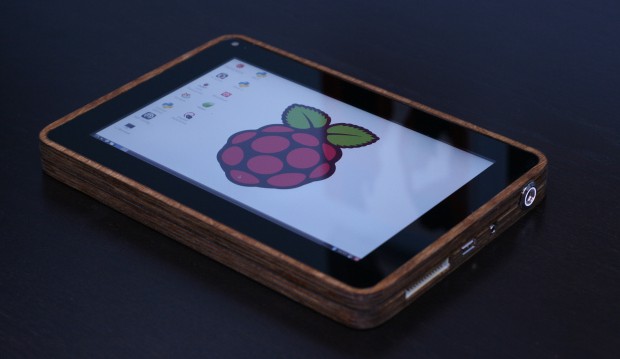[Michael Castor] wanted a tablet, but not just any tablet. He wanted an all-in-one system running Linux, and he wanted it to look good. So he made himself a wooden PiPad.
He started the project at the beginning of 2013, and like many of our projects, it took a little while to get some momentum going. He bought most of the components early on but then it got pushed to the back burner. Two weeks before the Maker Faire Bay Area 2013, [Michael] decided he wanted to show it off, and thus began the mad dash to finish it in time.
The build consists of a very nice piece of 1/2″ Baltic birch plywood which was cut to shape using a CNC router. A scrap piece of carbon fiber makes for a stylish but not too flashy back cover — He even managed to get [Eben Upton] to sign it! Inside is a 10,000mAh lithium ion battery, a Raspberry Pi, a cellphone battery charging system and a capacitive touchscreen LCD. Almost all touchscreens run off 12V, but [Michael] managed to find a 5V HDMI to LVDS converter, which works perfectly. The device gets about 6 hours of battery life, which is more than enough for [Michael]. The device looks great, and he’s even made it through airport security with it!
We love seeing unique projects like this — don’t forget to submit your own projects through our Tip line!

















>PiPad
lawsuits coming in 3…2…1…
And suddenly nothing happened…
This build came out awesome!! Congrats man. I would actually love to see a few more pics of this build. Job well done.
+1
EXCELLENT!!!
This beats any Apple product with the ‘GREEN’ in the mix…
I hate to break it to you, but one-off handmade projects are a lot more energy intensive per-unit than a modern factory. Economy of scale wins every time. Apple sweeps up their machined shavings and recycles them, do you?
You mean Apple factory slaves sweep up the shavings.
ashes to ashes, and dust to dust….
I did the exact same build over a year ago. I was one of the first to buy a LVDS converter and display from chalk-elec and my chassi was made out of walnut and had charging HW and batteries from a Sony mobile phone. It worked great but the screen was later relocated to my car. The touch drivers were not great when I did my project so I had to do a lot of tinkering before it worked as intended…
Perhaps one should submit the gizmos here that we build?
Sign me up this is sweet here take money $$$$$$$
“The device looks great, and he’s even made it through airport security with it!” ohh cool make something that looks like a commercial product and they don’t even question what it is. But any PCB with some wires is regarded as a potential bomb
Linking straight to Make… Not even trying anymore :,(
It’s a great build whoever did it — why would we only share projects not already covered? Make or not make, it deserves a feature!
Very clean build.
Once again the RasPi is a solution looking for a problem, and owners are attempting to justify their purchase.
the RasPi is a great micro Linux host suitable for a lot of of projects where linux and diy hardware communication via GPIO is needed. This project however is not really suitable for the Pi. Lokking at the videos you can see the poor performance of the Gui.
I can’t think of many projects which would need a (relatively) powerful CPU with poor GPIO performance.
Audio/video synthesis?
The Raspberry Pi is just a cheap little single-board computer with some features that make it very useful for teaching computer science to people who might not even otherwise afford a computer.
GPIO is incidental, not a main feature. Many people never even touch those pins, instead using it for XBMC or as a small server. Think of it like the BeBox’s geekport.
I happen to have one running Octoprint, attached to my ORD Bot Hadron. It’s a nifty device, it’s easy to use, and it’s not expensive.
Justify $60, maybe? Why would you need to justify $60?
once again matt is under the mistaken impression that his own opinion is the only one that matters
go back to reddit where you can hide anyone’s comments which hurt your feelings